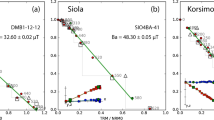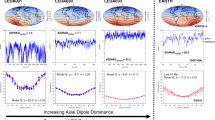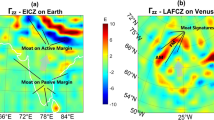Abstract
Hot spots are located on the Earth's surface and are caused by hot plumes of upwelling mantle material. They manifest themselves by volcanic activity which changes its location in response to the movement of the lithosphere over the mantle plume. It has been suggested1–3 that hot spots are relatively stationary with respect to each other, and also that they represent a frame of reference with which to measure the absolute movement of the lithospheric plates over the surface of the Earth. Another frame of reference can be partially defined by the position of the mean magnetic dipole field of the Earth. As the dipolar field is believed to be closely related to the spin axis, this frame of reference automatically gives information about the palaeolatitude and orientation of the lithospheric plates. But since the position of the ancient dipole field of the Earth does not give any information about palaeolongitude, and since in many cases the definition of the field is relatively poor due to less than adequate rock collections during the time of interest, hot spot reference frames have been favoured by many people. We now report a comparison of the two frames of reference and show that over the past 200 Myr there has been relative movement between the two frames of reference of about 20°, and that this motion has not been constant with time.
This is a preview of subscription content, access via your institution
Access options
Subscribe to this journal
Receive 51 print issues and online access
$199.00 per year
only $3.90 per issue
Buy this article
- Purchase on Springer Link
- Instant access to full article PDF
Prices may be subject to local taxes which are calculated during checkout
Similar content being viewed by others
References
Morgan, J. W. The Sea 7, 443–487 (1981).
Minster, J. B. & Jordan, T. H. J. geophys. Res. 83, 5331–5354 (1978).
Chase, C. G. Earth planet. Sci. Lett. 37, 355–368 (1978).
Harrison, C. G. A. & Lindh, T. B. J. geophys. Res. 1903–1920 (1982).
Barron, E. J., Harrison, C. G. A., Sloan, J. L. & Hay, W. W. Eclog. geol. Helv. 74, 443–470 (1981).
Embleton, B. J. J. & McElhinny, M. W. Earth planet. Sci. Lett. 58, 141–150, (1982).
Barron, E. J., Harrison, C. G. A. & Hay, W. W. EØS 59, 436–449 (1978).
Duncan, R. A. Tectonophysics 74, 29–42 (1981).
Author information
Authors and Affiliations
Rights and permissions
About this article
Cite this article
Harrison, C., Lindh, T. Comparison between the hot spot and geomagnetic field reference frames. Nature 300, 251–252 (1982). https://doi.org/10.1038/300251a0
Received:
Accepted:
Issue Date:
DOI: https://doi.org/10.1038/300251a0
This article is cited by
-
Plate tectonics and Earth’s magnetism: a personal viewpoint
La Rivista del Nuovo Cimento (2021)
-
Large-scale motion between Pacific and Atlantic hotspots
Nature (1995)
-
Latitudinal shift of Pacific hotspots during the late Cretaceous and early Tertiary
Nature (1987)
-
India–Eurasia collision chronology has implications for crustal shortening and driving mechanism of plates
Nature (1984)
-
Palaeomagnetic estimates of crustal shortening in the Himalayan thrusts and Zangbo suture
Nature (1984)
Comments
By submitting a comment you agree to abide by our Terms and Community Guidelines. If you find something abusive or that does not comply with our terms or guidelines please flag it as inappropriate.



